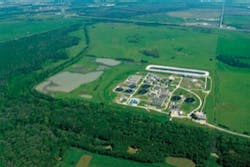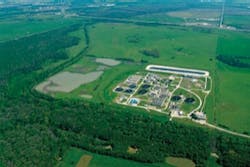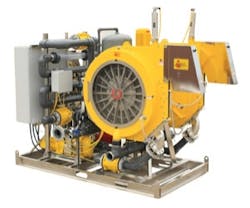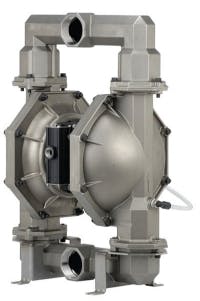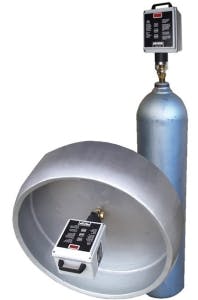[Case Study, March 2009] -- Late in 2008, after two and a half years of construction, purification centers were switched on, pumps were activated and water flowed through 200 kilometers of large-diameter pipeline -- marking completion of construction for the $2.5 billion Western Corridor Recycled Water Project.
Producing up to 232 megaliters of water a day, the Western Corridor Recycled Water Project is the largest in the Southern Hemisphere and the third largest in the world. It provides purified recycled water - a climate- and rainfall-resilient source of pure water -- to three power stations located at Tarong and Swanbank. In future, the Project will supply water to industry and potentially agricultural users, and should the region's drinking water supplies fall below 40 per cent, the Wivenhoe Dam.
The Project includes a network of more than 200 kilometers of large-diameter underground pipes, three advanced water treatment plants, nine storage tanks and 12 pumping stations.
The Project also provides significant environmental benefits by removing nutrients from water that is released to waterways flowing to environmentally sensitive Moreton Bay.
The Western Corridor Recycled Water Project is now owned by a Queensland Government statutory authority known as WaterSecure, which also owns the Gold Coast Desalination Plant. WaterSecure provides a safe and sustainable source of pure water for South East Queensland, with the capacity to produce up to 365 megaliters of pure water each day, providing water security for the region.
More than 200 kilometers of pipelines, pump stations and balance tanks link the system. The pipeline starts at Luggage Point and Gibson Island advanced water treatment plants at the mouth of the Brisbane River, travels through Brisbane's eastern and southern suburbs and meets the Bundamba advanced water treatment plant at Ipswich. Purified recycled water pipelines travel in multiple directions from Bundamba. One pipeline leads to the Swanbank power station. A second pipeline continues north to Caboonbah at the top of Wivenhoe Dam, where it taps into an existing pipeline and takes water to power stations at Tarong.
Producing purified recycled water
Testing has demonstrated that water produced by the Project meets the Australian Drinking Water Guidelines. Water undergoes the world's most rigorous purification processes, including real-time water quality monitoring, and testing for more than 400 parameters.
The Western Corridor Recycled Water Project's advanced water treatment plants contribute three essential barriers of the advanced water treatment process -- microfiltration, reverse osmosis and advanced oxidation.
• Microfiltration forces treated water under pressure through tiny straw-like filters that remove suspended material and micro-organisms including some viruses
• Reverse osmosis pushes water under high pressure through a semi-permeable membrane, removing viruses, organic compounds and inorganic compounds such as salt.
• Advanced oxidation is the final step of the advanced water treatment process. It uses hydrogen peroxide and ultraviolet light to destroy any remaining compounds. The outcome is a pure, safe and secure source of water that meets the Australian Drinking Water Guidelines.
Keith Davies, CEO of the Western Corridor Recycled Water Project and WaterSecure, says the Project's advanced water treatment processes are second to none.
"The Western Corridor Recycled Water Project is exceptional because it combines the best technologies known to humanity to produce one of the purest sources of water in the world," he says.
"No other water project in the world uses the same level of advanced water treatment processes that we use in Queensland. This is the first time that microfiltration, reverse osmosis and advanced oxidation have been combined within individual purification centers.
"The Project's quality has not gone unnoticed. Our work has been hailed around the world and was recognized by 11 international and national awards, including the 2008 'Water Reuse Project of the Year' at the Global Water Awards and the 2008 'International Project of the Year' from the Construction Management Association of America.
"International delegations from all over the world have praised the Project and the environmental considerations we have made, as well as our best practice examples in design, construction and water treatment technologies.
"We've already provided more than 15 billion liters of pure water to Swanbank and Tarong power stations. This water is safe and satisfies stringent requirements of the Australian Drinking Water Guidelines."
Davies says each advanced water treatment plant must undergo a comprehensive validation and verification process.
"Validation involves confirming that the advanced water treatment plant is operating as designed and according to design specifications," he says.
"Verification ensures the advanced water treatment plant is consistently producing water that complies with water quality standards."
Davies says the quality of water is further guaranteed by the Water Supply (Safety and Reliability) Act 2008.
"All water produced by the Project must meet strict water quality and health standards outlined within this new regulatory framework," he says.
"This Act exists to protect public health and ensure the Project can continue to operate and protect public water supplies.
"Under the Act, we are required to produce a recycled water management plan that identifies risks and details actions to minimize these risks.
"The Queensland Water Commission has also established a panel of international experts to provide the highest quality, independent technical advice. This panel includes world leaders in ecotoxicology, environmental science, public health, environmental microbiology, limnology and advanced water treatment."
Improving outcomes for Moreton Bay
Davies says the Western Corridor Recycled Water Project will leave a positive environmental legacy that will last for generations.
"Firstly, the amount of water supplied by the project is equivalent to a large scale dam. By providing this water from another source, we are preventing the need for at least one extra dam to be built in the future," he says.
"In the immediate term, the Project is improving water quality in the Brisbane and Bremer rivers, which flow to Moreton Bay, an environmentally sensitive and internationally recognized wetland. Nutrients that would otherwise be released to these rivers are removed in the treatment process.
"For example, treated wastewater is no longer released to the Bremer River at Bundamba. This reduces levels of phosphorus and nitrogen in the river, meaning we can expect an improvement in aquatic ecosystems including plant life, fish stocks and invertebrates.
"Where reverse osmosis concentrate is released to the Brisbane River, nutrient levels have been greatly reduced."
Davies says innovative construction procedures have allowed the Project to provide positive environmental outcomes.
"Horizontal directional drilling is a great example of sustainable infrastructure practices. It replaced traditional trench crossings at a number of locations, including the Brisbane River, Aquarium Passage and the lower reaches of Bulimba Creek. HDD minimized the impacts on sensitive environments and critical infrastructure."
2.5 years of construction -- a phased approach
Because of its size and complexity, the Western Corridor Recycled Water Project was delivered in stages known as 1A, 1B, 2A and 2B. Western Corridor Recycled Water Pty Ltd successfully met the construction deadlines for all project stages.
Stage 1A was designed to take immediate pressure off the Wivenhoe Dam by supplying Swanbank power station with up to 20 megaliters of water a day. It comprised construction of the first stage of the Bundamba advanced water treatment plant and associated pipelines, and was completed after just 10 months of construction.
Stage 1B upgraded the capacity of the Bundamba center to 66 megaliters of water a day and began supplying water to Tarong and Tarong North power stations. It included construction of almost 100 kilometers of pipeline and was completed in June 2008, just nine months after water first flowed to Swanbank.
Stage 2A entailed construction of the Luggage Point (66 megaliters a day capacity) and Gibson Island (50 megaliters a day capacity) advanced water treatment plants, and more than 80 kilometers of underground pipeline. This pipeline was constructed through some of South East Queensland's most developed regions and posed considerable challenges. Stage 2A was completed on October 31, 2008 and marked the first time the entire 200 kilometer system was linked together as a completed whole.
Stage 2B, completed in December 2008, upgraded the Gibson Island advanced water treatment plant, increasing its capacity to 100 megaliters a day.
While construction of core project elements is now complete, further drought contingency works are underway to upgrade the system's yield and ensure the pipeline can efficiently transport increased volumes of water.
Keith Davies says the Project has set industry benchmarks and will remain a key element of South East Queensland's water supply strategy for generations.
"The project alliances have toiled night and day to bring the project in on time and under budget, but most importantly they've done it safely, with a lost-time injury rate well below industry standards," he says.
Sixteen of the world's leading construction, engineering, project management and water services companies formed five alliances to construct the Project, along the way employing thousands of specialists from more than 40 countries and clocking up almost seven million work hours.
The alliance approach involved significant collaboration between the Queensland Government and private companies, with common alliance themes being a risk-sharing and reward-sharing culture with unanimous decision-making.
Bundamba Alliance -- Thiess-Black & Veatch
Bundamba Alliance completed construction of the Bundamba advanced water treatment plant, which produces up to 66 megaliters of purified recycled water a day. The Thiess-Black & Veatch Joint Venture completed Stage 1A of the center in August 2007, less than 10 months after construction commenced. In winning the 2008 International Water Reuse Project of the Year Award, judges described Bundamba 1A as a "technical masterpiece."
Despite work continuing for up to 24 hours a day, six days a week, excellent standards were maintained with 1.7 million workforce hours completed without a lost time injury. International delegations have praised the design and fast-track nature of procurement and construction activities of the center, as well as the safe working operation of the site.
Gibson Island Alliance -- MWH, Worley Parsons, Baulderstone Hornibrook and United Group Infrastructure
Gibson Island Alliance is responsible for constructing the Gibson Island advanced water treatment plant, which produces up to 100 megaliters of purified recycled water a day. The Alliance constructed the Project's largest center on the smallest site, and subsequently embraced a culture of innovation to ensure results are delivered and objectives achieved. More than 30 innovations were delivered during construction, with a number of these being implemented following suggestions from the construction workforce. At present, further drought contingency works are underway.
Luggage Point Alliance -- CH2M Hill, Laing O'Rourke, Connell Wagner, Hatch
Luggage Point Alliance constructed the Luggage Point advanced water treatment plant, which produces up to 66 megaliters of water a day. The Luggage Point Alliance initially constructed a pilot center to simulate a full-scale advanced water treatment plant. This pilot center tested different membrane technologies to establish the best combinations that would ensure the highest quality and consistency of water produced. At present, further drought contingency works are underway.
Eastern Pipeline Alliance - AJ Lucas, Transfield Services, GHD
Eastern Pipeline links Luggage Point and Gibson Island to the Bundamba advanced water treatment plant. Eastern Pipeline Alliance constructed 104 kilometers of underground pipelines, 10 pumping stations and seven balance tanks and managed around 50 crossings of roads, railways and major waterways, including the Brisbane River. Pipeline construction occurred through a heavily built up area and was complete in October 2008. At present, further drought contingency works are underway.
Western Pipeline Alliance - McConnell Dowell, Abigroup and GHD
Western Pipeline comprises the pipeline that transports water west of the Bundamba advanced water treatment plant. The Western Pipeline Alliance constructed more than 80 kilometers of large-diameter pipeline, two pumping stations at Bundamba and Lowood and two balance tanks at Esk and Lowood. Pipeline construction was completed in June 2008.
Starting at the Bundamba advanced water treatment plant, the pipeline travels north-west for 32 kilometers to a five-megaliter balance tank and pump station at Lowood. The pipeline then splits into two, with one pipeline heading 48.5 kilometers north to Caboonbah, via the Esk balance tank, where it links with pipelines supplying water to the Tarong power stations. The second pipeline heads 16.4 kilometers to Coominya, where water will be released into Wivenhoe Dam once combined dam levels fall below 40 per cent.
The Alliance was recognized for its speed of pipeline construction, with more than 50 per cent of the pipeline being built in just six months and, on one day, a massive 1.52 kilometers of pipe was laid.
Davies says WaterSecure will provide the water required to ensure a positive future for South East Queensland.
"Water is the fundamental element that we simply can't do without. And in a region increasingly affected by climate change, extreme drought and substantial population growth, access to fresh water is more important than ever.
"WaterSecure is the outcome of two years of innovation, excellence and plain hard work.
"We've looked to the best examples overseas and throughout Australia to provide reliable answers to Queensland's water supply requirements.
"We've combined two climate-independent water sources to produce a pure source of water that will directly assist South East Queensland's population growth, economic growth and water supply certainty for generations to come. We're immensely proud of our efforts and those of our alliance partners."
###
